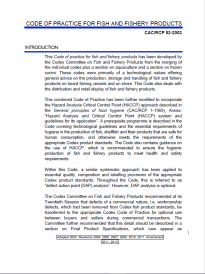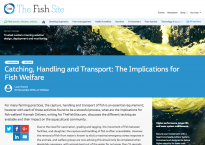Handling After Harvest
Harvest and handling during aquaculture refers to the activities which take place when fish and shellfish are removed from the pond, cage or other production unit, and before the products are marketed for human consumption as food. What happens to fish during this crucial period has implications for food loss and waste (FLW) at this stage and in the subsequent stages of the value chain.
Unless harvested quickly with minimal stress and damage, properly handled, and chilled, then spoilage and quality deterioration will be accelerated. This is especially prudent in tropical areas, where ambient temperatures are high and conducive to rapid bacterial growth. For products which are to be marketed live, poor harvesting techniques and improper post-harvest handling will increase the risk of mortality of fish prior to and during marketing.
Harvesting is one of the most important activities of fish farming. It is an important step in getting fish out of production facilities in good condition so their survival and quality for other uses are assured. Aquaculture facilities vary considerably in terms of production technique, level of investment, size, and whether production is land based or cage culture is used.
The key causes of FLW, which are mainly linked to quality and to the mortality of fish during live fish marketing, include:
- not starved properly before harvesting increases the risk of mortality during live marketing
- harvesting is slow and stressful
- contaminated with mud and dirt from pond or production environment
- contact with unclean surfaces and unclean staff increasing bacterial load
- fish not washed before being iced
- delay in chilling which leads to quality deterioration
- physical damage during harvesting and handling that leads to bruising and damage to fish flesh, accelerating spoilage and mortality of live fish
- bleeding delayed or inadequate bleeding that leads to discoloration of fillets and loss in value
- malfunction of live fish holding and transport technology causing mortality
Extreme deterioration in quality of fish can lead to waste. However, one of the advantages of aquaculture over capture fisheries is that it is possible to have more control over the timing and conditions of harvesting and see subsequent handling process. There is less unpredictability in aquaculture as the species and quantity of fish or shellfish to be harvested is known and harvesting can be conducted at the suitable time conducive for good handling as well as for marketing.
Key Publications
Quality and Quality Changes in Fresh Fish The book describes fundamentals in fish biology, chemical composition of fish, and post-mortem changes, with a view to explain the rationale for optimal catch handling procedures and obtaining maximum shelf life. | |
Code of Practice for Fish and Fishery Products CAC/RCP 52-2003 Global standard that presents information on freezing and cold storage practices which aim to reduce spoilage and waste. | |
Catching, Handling and Transport: The Implications for Fish Welfare Discusses different techniques of capture, handling and transport of fish within aquaculture. |
More Resources
More Resources
27 February 2024
31 October 2023
05 September 2023














